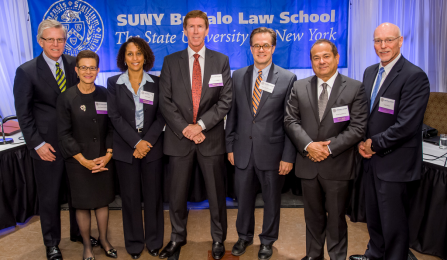November - 2013
Trial competitors learn from the best

Panel participants: Terrence M. Connors ’71, Judge Sheila, Trini E. Ross ’92, Mark O’Mara, Hon. Thomas P. Franczyk, Paul J. Cambria Jr., and Don West '80.
Students from SUNY Buffalo Law and 36 other law schools who were in town for the Buffalo Niagara Trial Competition heard top area and national litigators share their hard-won wisdom about trial tactics.
Where to stand when your star witness is testifying. How to control an argumentative witness. How to start connecting with jurors even during voir dire. When to object – and when not to. Those topics and many more were the substance of an eminently practical Law School forum at which top area and national litigators shared their hard-won wisdom about trial tactics.
The panel discussion, “Success at Every Stage of Trial,” was held Nov. 7 in the Buffalo Niagara Convention Center. It was presented in conjunction with the Buffalo Niagara Trial Competition, which celebrated its 10th anniversary this year, and many in the crowd of about 250 were students from SUNY Buffalo Law and other law schools in town for the competition. Thirty-six schools from 19 states and the District of Columbia were represented in the competition, said Hon. Thomas P. “Tim” Franczyk, an Erie County Court judge who co-directs the Law School’s Trial Advocacy program and serves as competition director.
Franczyk also moderated the panel discussion, saying, “I believe that the trial process is more in the nature of a marathon than a 40-yard dash. You have to fight little skirmishes every step of the way.”
The panelists were Terrence M. Connors ’71 of Connors and Vilardo; Paul J. Cambria Jr. of Lipsitz Green Scime Cambria; Erie County Court Judge Sheila A. DiTullio; Assistant U.S. Attorney Trini E. Ross ’92; and two attorneys who won acquittal for defendant George Zimmerman in the highly publicized shooting of Trayvon Martin in Sanford, Fla., Mark O’Mara and Don West ’80.
It was a lively discussion as the practitioners traded stories and compared strategies across the breadth of the trial process, from the first meeting with a new client through closing arguments. Some highlights:
On starting to work with a new client:
“As a defense lawyer, right away you’re a couple of touchdowns behind,” Connors said. “Your first interview is with the client, and that is a worthless interview. They spend the whole time trying to convince us they’re not guilty. The goal is to get them reassured that there’s a path through this process that can be navigated successfully. What am I facing, what am I looking at, and how do I blunt that?”
In the first interview, West said, “I’m looking first and foremost at trying to establish a relationship and a rapport with the client. The client can be a source of information. Then there’s the discovery track, what you get from the other side. The third track is your investigation, when you hit the ground with an investigator.”
On jury selection:
“The most important part of a trial, after the preparation, is selecting a good jury,” DiTullio said. “If you don’t have a jury you can work with, you’re done. … Common sense is so important. If you feel a juror doesn’t like you, for whatever reason, or likes the prosecutor – done, that juror’s off.”
The opening statement:
“This is a really good opportunity to give a road map of where the prosecution is going with the case,” Ross said. “People don’t like surprises, and I don’t want any surprises in my case. What I don’t do in an opening statement is to make promises that we can’t keep. I’m very methodical in taking jurors through my timeline. And I try to tell the story from the perspective as if the jurors were there, put them in the scene.”
On direct examination:
“I always like to put my sharpest witness on first,” Ross said. “The most important thing is to tell that story inch by inch by inch. I have watched people conduct a direct with a key witness and it’s done in four or five minutes, and a jury is supposed to convict on that? … The jury is hearing this case for the first time, and they’re dying to hear from this key witness.”
About when and how often to object:
“Over my career, I’ve learned to object less,” O’Mara said. “If you keep in mind who your true audience is, those six or 12 people, all the rest are actors. That jury doesn’t know what an objection is, particularly; all they know is, I’m listening, and that guy is saying something. If you stand up and your objection is overruled one, two, three times in a row, you just become another irritant, because the jury wants to hear the story.”
On cross-examination:
“I try not to cut them off,” West said. “When I prepare witnesses for cross-examination, I always tell them it’s a losing proposition to argue with the lawyer. I like it when a witness argues with me, because at the end of the day it’s their credibility that’s on the line, not mine.”
“If I ask a witness a question,” Cambria said, “and they proceed to give me an answer about something I never asked them, I say, ‘Please, I didn’t ask you that, I asked you this,’ and I use ‘please’ to stop them at that point. … I like to go in immediately and show them who’s boss. I use accounting paper with all the columns on it, and I take each statement in chronological order, and if they make inconsistent testimony I draw lines from this day to that day, and then I unfold that baby in front of them.”
About closing arguments:
“These jurors have been in this trial for two or three weeks and then it hits them, they have to make a decision,” DiTullio said. “You want in closing to say, this is what you have to do and don’t stress over it. Our job is to keep that trial civilized from beginning to end. From day one you feel the stress and the tension. The lawyers have a huge responsibility, you have families of the victims, families of the defendant – everyone in that courtroom has been waiting a year or two for that trial, and there is tension. My job is to keep everyone calm.”
“You’re going to have some jurors identify with your client,” Connors said. “One of the main purposes of summation is to argue your case in the jury room. Someone’s going to say, ‘What about this eyewitness?’ and you can say, ‘Remember, this witness saw it just for a flash and the gun was in her face.’ You need to focus on that so some of the jury can argue for you. Because some of those jurors will be your advocates.”
“Jurors are just ordinary folks,” Cambria said. “You have to make them feel comfortable and you have to know what makes them click. It’s those cliché feelings that people have about things. I try to convince jurors in my summation that it’s just common sense that this particular person wasn’t truthful, for example, or this particular expert didn’t tell you what you didn’t already know. In other words, make it comfortable for them to accept your side.”
And to an audience question about “how do you sleep at night” after defending someone accused of a particularly heinous crime:
“I train prosecutors and cops for a living,” O’Mara said. “Our job is to hold the state to task and make sure they do their job right. You have to divorce yourself from the emotions of the case itself in order to be a true professional. It’s a delicate balance between maintaining your integrity as a person and being a good advocate for your client. If you take the case, you’ve got to give it your all and litigate as best you can in the best interests of your client.”
